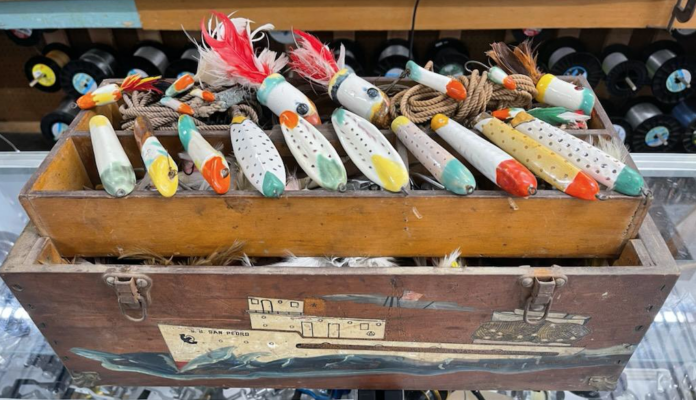
BY BUD CHADDOCK
The city of Avalon on Santa Catalina Island could be considered the birthplace of sportfishing and most likely laid the foundation for angling techniques we currently use today. Dr. Charles F. Holder, founder of the Catalina Tuna Club, caught the very first tuna on rod and reel in 1898, and the fish weighed 183 pounds. Many famous people around at that time as well as fishermen made Avalon the place to go, and Holder’s catch may have been the allure that brought returning fishermen back each year.
Most of the larger tuna were caught using flying fish, just as some anglers use today. But not everyone used flying fish, as some used lures made of pottery. It’s hard to believe that someone would make a lure out of pottery that could be easily broken, but fishermen are known to try anything. After all, Catalina was famous for pottery of great beauty and style, so it’s not surprising that the Catalina Pottery Company made fishing lures out of pottery. The company had a variety of colors and glazes which became their trademark.
Colors were generally white, yellow, green, orange and red. Some were in hues that were blended in a mottled fashion, as well as two-tones in some. Some looked like single hook jigs in shape, others had odd looks as far the appearance went. Nonetheless they were part of the rich history of the island, and to this day, the Catalina Island Museum in Avalon has examples in their archives.
Patty Salazar, an employee at the museum, assured me that the lures were made there, but not in great quantity like the other pottery items. She was able to send photos of the limited examples they had on hand in the museum. If you visit Catalina Island, you should stop by the museum to see the amazing history of the area and take a peek at these unusual pottery jigs.
The Catalina Pottery jigs came in several glaze colors and shapes. There were some with groove-head teaser shapes with feathers for catching bill fish and tuna. Some had a surfboard-look to them and were used for catching yellowtail, bonito, barracuda and calico bass. Some lures had a flatter appearance like the Flat-Falls of today. Some had spots painted on them over the various glaze patterns.
There were also some lures with a bullet-shaped head with a feather protruding out the rear like many fly lures we see now. I would not see much use for these other than for bonito, but who knows. Perhaps they worked well at the island for some other targeted species. But then again, we can speculate — maybe the worker who designed them wanted one for an upcoming trout trip in the Sierra.
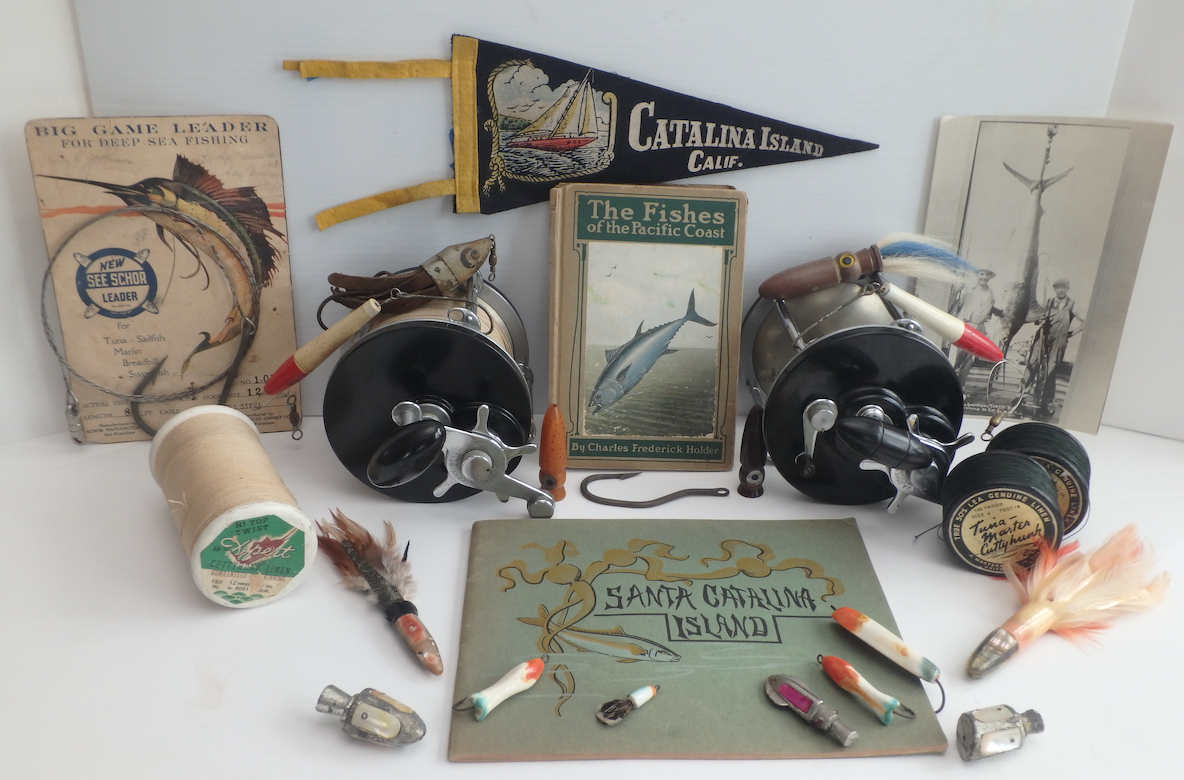
There were additionally odd ones with rectangular-hollow-shapes, and solid ones with 45-degree angles at one or both ends, maybe to jig up and down like a hex bar for bottomfish. All of these lures were delicate, and I am sure they would break with a head slap of a fish on the deck. Nonetheless, they are part of the West Coast’s jig history and the pottery history of Catalina.
Eric Huff of Eric`s Tackle in Ventura, located at 2127 E. Thompson Blvd., carries on the tradition of the neighborhood tackle store. In a time-honored tradition, Huff offers customers local info and help on improving their catches using modern-day tackle. He operates the business with pride and passion for the art of sportfishing. Yet when you walk into Huff’s tackle store, you enter into a time capsule into the past with displays of various jigs that were used from the turn of the century, demonstrating the ingenuity of the fishermen who designed the lures.
In one of the cases are the Catalina Pottery lures, which showcase the artistic quality of these delicate lures. Huff and his father, Wayne, have the best examples of Catalina Pottery lures that I have seen. Wayne has the nicest overall Catalina Pottery collection of everything they have made from pottery, even better than the island’s museum. It’s great to know they have preserved this heritage and share a father-son love and passion for these items.
Notice the folk-art picture of the tuna bait boat with the lures and line in it. I remember seeing some of these boats in my younger years at the dock in San Pedro, and also when unloading a catch of fish at canneries such as StarKist, Van De Kamp, Carnation and Chicken of the Sea at Terminal Island. I can still remember the smell. Seeing the folk-art picture reminds me of when I caught many fishing this way with jigs and lift poles, later to be put into cans that made it to the store shelf.
I remember meeting Gilbert Van De Kamp III in my youth through a friend and captain I worked for, Bill Hilton. Gilbert Van De Kamp III had an 85-foot boat called the Vantuna, built in 1961 by Dittmar-Donaldson in Costa Mesa. Van De Kamp had this boat built to be used as a commercial fishing boat which was off-loaded at the site of the Van De Camp cannery on Terminal Island. It has the same hull as the Freedom, Liberty and Grande which are still afloat today and bringing smiles to the many anglers who still board them for a fishing adventure.
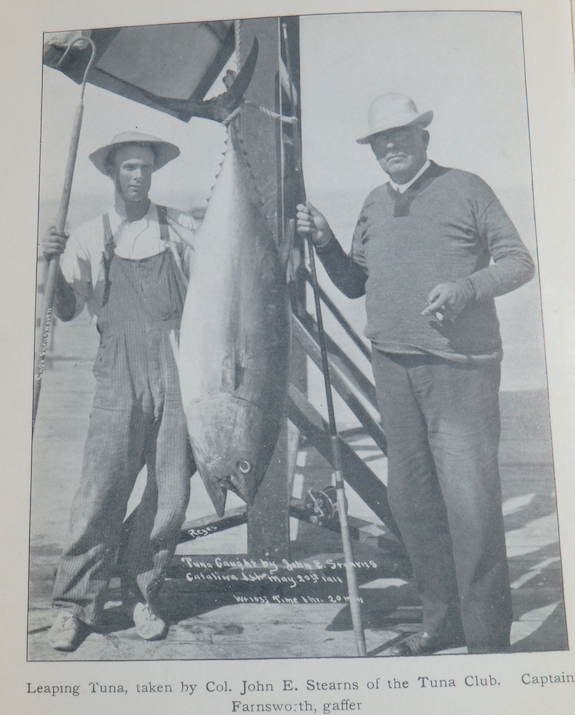
In addition, what fisherman, dock worker or cannery employee could forget Joe Biff’s bar on Terminal Island? Biff’s is like a scene from the movie the Perfect Storm, with all the characters at the bar sharing their fishing tales while visiting with friends and coworkers with an older, retired fisherman at the end of the bar was saying, “I remember the Flemish Cap.”
Many a fisherman’s check was spent at Biff’s. A fellow crew mate of mine made the choice to have the Chicken of the Sea mermaid/logo tattooed on his arm. As I recall, his decision to get a tattoo of the mermaid emblazoned on his arm is another memory of a good choice I made during my early years. However, it’s amusing to think about the incident which led to how the tattoo found an arm to be on. This is my redacted version of this story, and I’m sticking to it.
There are modern day anglers like Dave Pfeiffer of Shimano who use techniques of the old days to recapture what it was like to catch tuna in a fashion like his predecessors. Using period fishing gear of Avalon’s early years, he qualified for the Avalon Tuna Club’s standards to secure a place in the history of the club. He accomplished this by using a flying fish like many before him from the late 1890s until now.
To qualify, you had to use older tackle with linen line, 24 threads to be exact. Pfeiffer used a J.A. Coxe reel in a 12/0 size from the era of the ‘30s to the ‘40s and held 1,135 yards of the line, according to the company that made it.
The reel was mounted on a hickory or ash rod from the same era. There was also a double line using the old wax thread method to be correct for the Tuna Club standards. Then Pfeiffer and his crew floated a dead-rigged flying fish out away from the boat as they drifted towards a big school of boiling tuna. The fish blew up on it, and it was fed line for about 10 seconds before the reel was put in gear and the battle ensued. It made a long run, about 100 yards and sounded. It came up mostly dead after 45 minutes of battle on this old gear.
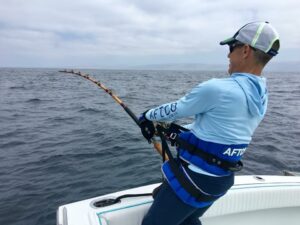
The linen line is heavy when wet and has considerable drag, which causes the line to bow. They think (back in the day) this wore the fish out due to the line occasionally wrapping the tail of a big fish. It was probably a good thing considering they had leather thumb straps for drags in the early days to apply pressure.
Back in the day, the doctors had a lot of patients with injured hands due to the knuckle-buster reels with poor drag systems. Well, all this paid off and Dave caught a modern-day fish on Tuna Club standard gear from an earlier period. His catch was a 219-pound bluefin, which earned him a certificate and button and put him into the Avalon Tuna Club’s record book.
Other fishing methods were also developed during the earlier period, such as kite fishing. This effective way of fishing using a kite was started by “Tuna George” Farnsworth, who’s believed to be the inventor of kite fishing in the 1900s. Kite fishing is a method which deploys the flying fish in a seductive way, 50 to 100 yards (or more) away from the boat the flying fish skips over the water in a life-like manner.
This method can work very well, and I have seen times when kite fishing is the only way to produce a bite in tough fishing conditions to entice the finicky bluefin. A bank on Catalina Island still bears Farnsworth’s name. If you are on Catalina Island, you will see the old Tuna Club in all its glory, a testament to Catalina’s rich history.
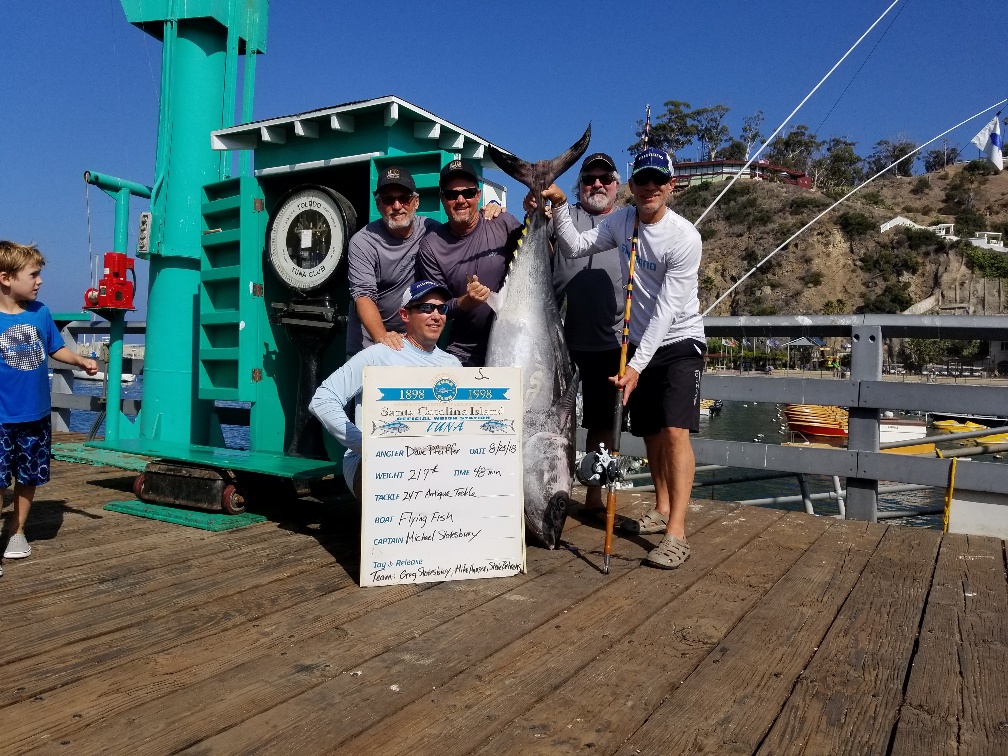
There are many people who add to our memories and have a place in the history of fishing. Some like Eric and Wayne Huff who gather artifacts, so we understand sportfishing’s roots.
Some like Dave Pfeiffer who adds his passion to the old craft of the past and incorporates it into today’s method of fishing, blending the old and the new, showing us all that these techniques can still be used today, and are still a part of Catalina’s history. Let’s also not forget the forefathers of fishing on the West Coast, which includes George Farnsworth and many others.
I would like to thank Dave Pfeiffer for sharing the story of his 219-pound catch. I also want to thank Eric and Wayne Huff for helping with pictures of the Catalina Pottery jigs. Thanks also to Gabby Talkington of antiquelures.com for items used in the pictures. Thanks to Patty Salazar at the Catalina Island Museum for her input. Without these people the stories presented would not be possible.



